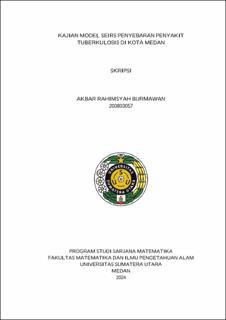| dc.description.abstract | This study aims to analyze the SEIRS (Susceptible-Exposed-Infected-Recovered-Susceptible) model of tuberculosis transmission by adding several assumptions to the rate of individuals transitioning from susceptible to latent (B), determine the equilibrium point and the basic reproduction number (Ro), and perform numerical simulations to analyze the results of the SEIRS model. The assumption of this SEIRS model is that there is a possibility that the population recovered from tuberculosis is susceptible to reinfection. This model consists of four compartments: the susceptible population, the exposed population, the infected population, and the recovered population. The data used are from the Medan City Health Office regarding the number of tuberculosis patients in 2022. Based on the results of the SEIRS model simulation, the smallest basic reproduction number (Ro) is obtained with B=0, resulting in Ro=3,9×10−7, and the largest basic reproduction number (Ro) is obtained with B=1, resulting in 7,9×10−6. Therefore, it can be concluded from these conditions that Ro<1, which means that tuberculosis is not an epidemic in the city of Medan and is decreasing from one generation to the next. | en_US |


